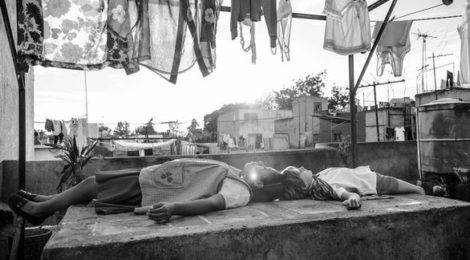
Special Dossier on Roma: Memories of C/Leo – On Auteurism and Roma
by Jeffrey Middents*
The press surrounding the release of Roma has emphasized its autobiographical qualities, elements that Alfonso Cuarón himself has confirmed in interviews throughout the production process. The film drops specific references to Cuarón’s other films, allowing cinephiles in the know to turn it into a familiar (and fun) auteurist game: sure, the family goes to see Marooned (John Sturges 1969) which looks suspiciously like a low tech version of Cuarón’s Gravity (2013), but what about the scene of Fermín’s nude martial arts harking back to Sólo con tu pareja (2001)? (Ten points goes to the person who can make Great Expectations (1998) work…) Perhaps wisely, at the time of this writing (concurrent with the immediate theatrical and streaming release of Roma), four of Cuarón’s earlier films – Sólo con tu pareja (1991), A Little Princess (1995), Y tu mama también and Children of Men (2006) – are also available on Netflix to assist with this potential bit of fun.
A self-aware auteur like Cuarón, however, knows that mere citation is not enough: Roma also operates in dialogue with his earlier films, allowing layers of meaning to develop. (Pedro Almodóvar has also done: the premises for both Todo sobre mi madre (1999) and Volver (2006) stem from individual – and unrelated – plot points within his earlier film La flor de mi secreto (1995)). This video essay quickly relates Roma back to its most obvious reference, Y tu mamá también, by overlaying that film’s narrator –intoned by Daniel Giménez Cacho – onto Roma’s rooftop scene. The narration largely consists of Tenoch’s memory of his nanny, called “Leo” in Y tu mamá también, which is triggered when he, Julio (Gael García Bernal) and Luisa (Maribel Verdú) pass the sign for her hometown (Tepelme). Significantly, he chooses not to say anything about it to the others in the car. Cuarón’s choice to name the main character the nearly homophonic “Cleo” invites direct comparisons between her and Leo: both movies feature C/Leo answering phones that the rest of the family ignores; both women are adored by the children; while Tenoch’s memory of Leo is triggered by a car ride to the ocean, Cleo actually travels with the children on a similar journey. Y tu mamá también features a single scene where we actually see Leo walking through the house, carrying a sandwich, after which she sweetly strokes the head of Tenoch; the actress playing that role is none other than Liboria Rodríguez, Cuarón’s actual nanny, to whom he dedicates Roma.
My focus on the rooftop scene in the video essay, however, invites another, more interesting comparison: after Paco refuses to (pretend) die (in a shoot-out game with his brother) and leaves the scene, the youngest brother, Pepe, sprawls dramatically on a piece of concrete, demonstrating the fact that he is “dead” (“muerto”). Particularly in the way that word is drawn out, the scene recalls a late scene in Y tu mamá también, when Luisa asks the little girl Lucero to show her the dead-man’s float (“uuuy, qué muerta estás”). I do not wish to attribute all of Luisa’s characteristics on Cleo, but this highlights that both women act as mothers while being simultaneously denied the possibility of being mothers themselves. As such, I have also brought in narration from that part of Y tu mamá también that originally accompanied the last time we see Luisa, diving into the ocean “. Transposed onto Roma, the words offer a newer perspective on Cleo. Who is to say, after all, that the “foam” from the sea is any less majestic and inspirational than the soap suds Cleo – and all the other domestic employees visible scrubbing on other rooftops in this scene – are washing away?
This video essay also highlights the richness and depth of Cuarón’s use of sound in both films, that match the complex mise-en-scène throughout his work. Y tu mama también is so attuned to teenage cacophony that, in order to provide context and history, the narration is presented with ambient sound turned off – an auteurist nod to Godard’s similar use of such narration in movies like Bande à part (1964). This made it relatively easy to lift the narration from one film without disturbing the complex soundscape of the other – but it also highlights how Roma evokes memory in a different aural manner. The deliberate pacing of the camera – there are only three shots in this scene, with the final shot lasting nearly 2 ½ minutes– corresponds with a softer symphony that supports the minimalist observations of Cleo and her surroundings.
*Jeffrey Middents is Associate Professor of Literature at American University in Washington, DC. His book, Writing National Cinema: Film Journals and Film Culture in Peru (2009) investigates the historical place of cultural writing within a national discourse by tracing how Peruvian cinema was shaped by local film criticism. He has also published print and video essays on documentary aesthetics in the work of Chilean filmmaker Particio Guzmán, Peruvian director Luis Llosa’s films made under producer Roger Corman, the theoretical perspective espoused by Kathryn Bigelow’s Strange Days, the sense of place in contemporary Latin American cinema, movie stardom and “the indigenous” in the works of Dolores del Rio and Magaly Solier, the pedagogy of teaching “world cinema” and the racial complexities of the television show Buffy the Vampire Slayer. He is currently working on a monograph on transnational auteurism and the work of Alfonso Cuarón.







That was a wonderful video essay, Jeff!
I’ll pass that on Tamara! See you at SCMS this year?